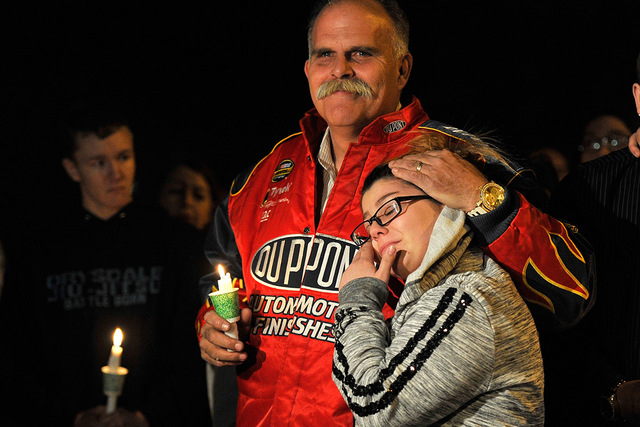What pushed Tammy Meyers’ killing into the national spotlight?
The topsy-turvy narrative of Tammy Meyers’ slaying has generated more questions than answers.
And those questions, along with the sense of mystery they evoked, are what drew national news networks to the Las Vegas Valley to report the story, experts suggest.
Meyers, 44, died Feb. 14, two days after police said she was shot down after a near collision in which the other driver threatened the mother and her 15-year-old daughter.
Police called it road rage, but details revealed since 911 was called show the killing is more complicated.
Las Vegas police investigated 128 homicides in 2014. That’s an average of almost 2.5 a week. Besides the killing of two Metro officers taking a lunch break in June, most mainly grabbed the attention of locals.
Then ABC, CNN, NBC and others jumped in.
So what’s so fascinating about the Meyers story?
Experts boil it down to this: Labeling it road rage, then following every twist and turn in the growing story, often with the drama unfolding on camera.
The Meyers family has been easily accessible to reporters since the Feb. 12 shooting. National media initially showed up for that, according to William Sousa, director of UNLV’s Center for Crime and Justice Policy. But they stayed to see how things played out.
And it’s not surprising, he said.
“When we think of crime, it’s the stranger incident we’re afraid of,” Sousa said Friday. “Incidents of violence are very common between acquaintances. What’s interesting is acts of violence committed by strangers.”
But in this case, the stranger element is gone.
The Meyers family knows the shooting suspect.
Erich Nowsch, 19, was arrested Thursday and faces a murder charge, among others. He lives a block away from the Meyers, right around the corner from where Tammy Meyers was shot in the head.
Roberts Meyers’ said his wife used to spend time with Nowsch, counseling him and giving him food and money. Neighbors said Nowsch struggled with his father’s suicide and that he sometimes got kicked out of his house.
But that wasn’t the only aspect of the family’s version of the story that was hidden the first few days they went on camera.
A police report shows Meyers recruited her 22-year-old armed son to accompany her on a pursuit of the four-door silver Audi that nearly crashed into her green 1993 Buick Park Avenue the night she was shot.
Sousa said it’s common for witnesses and family members to offer varying accounts of such a traumatic event. Determining whether road rage is involved in the killing is more difficult.
There’s little hard research on who feels such anger and why, Sousa said. Sometimes it can be chalked up to stress. Other times to a “behavior learned from a very young age.”
Road rage isn’t a legal term in Nevada, according to Metro Capt. Chris Tomaino. Neither local police nor state and federal agencies track it.
It’s too loosely defined to become an official statistic, Tomaino said, although he acknowledged the public’s attention to his department’s linking it to this death.
“If someone gets angered on the road and then gets in a fight at a bar or at their home, couldn’t that be considered road rage, too?” Tomaino asked rhetorically during a press conference Wednesday. “It’s more of an anecdotal issue that we’re really dealing with. Which is why some of us are having a difficult time getting our arms around it.”
University of Hawaii psychology professor Leon James is one of few scholars nationwide to conduct extensive research on the topic.
Some people who experience anger while driving can’t just shrug it off, James said in an interview Friday. They can carry grudges for minutes, hours or even days.
“It’s an intermittent explosive incident,” James said. “The feeling doesn’t go away unless you make a serious effort.”
James said incidents of road rage have been on the rise in recent years.
But Sousa disagreed, instead blaming media attention for creating an inflated sense of the crime’s frequency.
And media coverage — especially on TV — appeals to viewers’ fears, according to Jeff McCall, a media studies professor at DePauw University in Greencastle, Ind.
Stories such as Meyers’ can strike a chord with the masses, he said. And that’s not lost on those who can exploit it for ratings.
Look at this case: A mother dies after going out to give her daughter a driving lesson. A tearful father calls the accused killer an “animal” on live television.
“The shooting in Las Vegas is sad and tragic, of course, but frankly, it doesn’t need to be on the national news agenda,” McCall said Friday via email. “The supposed randomness of the shooting appealed to the media’s sense for the dramatic, and drove coverage before all of the details were available.”
The story is also easy for reporters to follow, thanks to the family’s willingness to go on camera and Metro’s “spoon feeding” of daily updates, McCall said. If the story required more hard reporting work, it might not have been so appealing to network news producers.
What drove Tammy Meyers to seek someone in a car who had already made her fear for her life — instead of calling police — is unclear. Like the other details in this death, it could take time for the facts to come forward.
And people will be watching.
Contact James DeHaven at jdehaven@reviewjournal.com or 702-477-3839. Find him on Twitter: @JamesDeHaven. Contact Chris Kudialis at ckudialis@reviewjournal.com or 702-383-0283. Find him on Twitter: @kudialisrj.



















